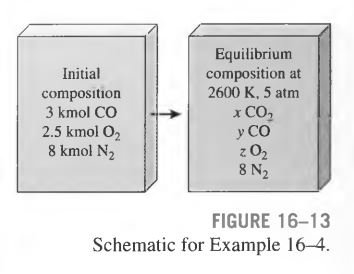Effect of Inert Gases on Equilibrium Composition
A mixture of 3 kmol of CO, 2.5 kmol of \mathrm{O}_{2}, and 8 kmol of \mathrm{N}_{2} is heated to 2600 K at a pressure of 5 atm. Determine the equilibrium composition of the mixture (Fig. 16-13).
Effect of Inert Gases on Equilibrium Composition
A mixture of 3 kmol of CO, 2.5 kmol of \mathrm{O}_{2}, and 8 kmol of \mathrm{N}_{2} is heated to 2600 K at a pressure of 5 atm. Determine the equilibrium composition of the mixture (Fig. 16-13).

A gas mixture is heated to a high temperature. The equilibrium composition at the specified temperature is to be determined.
Assumptions 1 The equilibrium composition consists of \mathrm{CO}_{2}, CO, \mathrm{O}_{2}, and \mathrm{N}_{2}. 2 The constituents of the mixture are ideal gases.
Analysis This problem is similar to Example 16-3, except that it involves an inert gas \mathrm{N}_{2}. At 2600 K, some possible reactions are \mathrm{O}_{2} \rightleftharpoons 2O (In K_{p}= -7.521), \mathrm{N}_{2} \rightleftharpoons 2 \mathrm{~N}\left(\ln K_{p}=-28.304\right), \frac{1}{2} \mathrm{O}_{2}+\frac{1}{2} \mathrm{~N}_{2} \rightleftharpoons \mathrm{NO}\left(\right. In K_{p}=-2.671), and \mathrm{CO}+\frac{1}{2} \mathrm{O}_{2} \rightleftharpoons \mathrm{CO}_{2} (In K_{p}=2.801 or K_{p}=16.461 ). Based on these K_{p} values, we conclude that the \mathrm{O}_{2} and \mathrm{N}_{2} will not dissociate to any appreciable degree, but a small amount will combine to form some oxides of nitrogen. (We disregard the oxides of nitrogen in this example, but they should be considered in a more refined analysis.) We also conclude that most of the \mathrm{CO} will combine with \mathrm{O}_{2} to form \mathrm{CO}_{2}. Notice that despite the changes in pressure, the number of moles of CO and \mathrm{O}_{2} and the presence of an inert gas, the K_{p} value of the reaction is the same as that used in Example 16-3.
The stoichiometric and actual reactions in this case are
Stoichiometric: \left.\mathrm{CO}+\frac{1}{2} \mathrm{O}_{2} \rightleftharpoons \mathrm{CO}_{2} \text { (thus } \nu_{\mathrm{CO}_{2}}=1, \nu_{\mathrm{CO}}=1, \text { and } \nu_{\mathrm{O}_{2}}=\frac{1}{2}\right)
Actual: 3 \mathrm{CO}+2.5 \mathrm{O}_{2}+8 \mathrm{~N}_{2} \longrightarrow \underbrace{x \mathrm{CO}_{2}}_{\text {products }}+\underbrace{y \mathrm{CO}+z \mathrm{O}_{2}}_{\begin{array}{l}\text { reactants } \\\text { (leftover) }\end{array}}+\underbrace{8 \mathrm{~N}_{2}}_{\text {inert }}
C balance: 3 = x + y or y = 3 — x
O balance: 8 = 2x + y + 2z or z=2.5-\frac{x}{2}
Total number of moles: N_{\text {total }}=x+y+z+8=13.5-\frac{x}{2}
Assuming ideal-gas behavior for all components, the equilibrium constant relation (Eq. 16-15) becomes
K_{p}=\frac{N_{\mathrm{CO}_{2}}^{\nu_{\mathrm{CO}_{2}}}}{N_{\mathrm{CO}}^{\nu_{\mathrm{CO}}} N_{\mathrm{O}_{2}}^{\nu_{\mathrm{O}_{2}}}}\left(\frac{P}{N_{\text {total }}}\right)^{\nu_{\mathrm{CO}_{2}}-\nu_{\mathrm{CO}}-\nu_{\mathrm{O}_{1}}}
Substituting, we get
16.461=\frac{x}{(3-x)(2.5-x / 2)^{1 / 2}}\left(\frac{5}{13.5-x / 2}\right)^{-1 / 2}
Solving for x yields
x=2.754
Then
y=3 – x=0.246
z=2.5-\frac{x}{2}=1.123
Therefore, the equilibrium composition of the mixture at 2600 K and 5 atm is
2.754 \mathrm{CO}_{2}+0.246 \mathrm{CO}+1.123 \mathrm{O}_{2}+8 \mathrm{~N}_{2}
Discussion Note that the inert gases do not affect the K_{p} value or the K_{p} relation for a reaction, but they do affect the equilibrium composition.